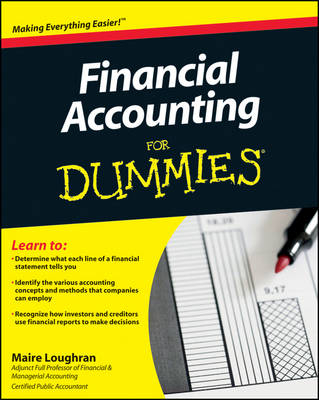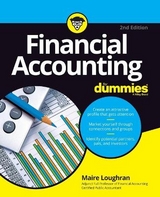
Financial Accounting For Dummies
John Wiley & Sons Ltd (Verlag)
978-0-470-93065-6 (ISBN)
- Titel erscheint in neuer Auflage
- Artikel merken
Your plain-English guide to navigating a financial accounting course Despite the economic landscape and job market, demand for accountants remains strong, and accountants will continue to see high demand for their services as the economy rebounds and businesses grow. Additionally, one of the effects of the economic downturn is a greater emphasis on accountability, transparency, and controls in financial reporting. With easy-to-understand explanations and real-life examples, Financial Accounting For Dummies provides students who are studying business, finance, and accounting with the basic concepts, terminology, and methods to interpret, analyze, and evaluate actual corporate financial statements. * Covers traditional introductory financial accounting course material * Explores concepts accountants and other business professionals use to prepare reports * Details mergers and acquisitions purchase and pooling, free cash flow, and financial statement analysis Whether you're a student on your way to earning a bachelor's degree, MBA, or MAcc, Financial Accounting For Dummies gives you a wealth of information to grasp the subject and ace the course.
Maire Loughran, CPA, is a member of the American Institute of Certified Public Accountants. An adjunct professor of auditing, accounting, and taxation courses, she is also the author of Auditing For Dummies.
Introduction. Part I: Getting a Financial Accounting Initiation. Chapter 1: Seeing the Big Picture of Financial Accounting. Chapter 2: Making Mom Proud: Financial Accounting Career Options. Chapter 3: Introducing the Big Three Financial Statements. Chapter 4: Acronym Alert! Setting the Standards for Financial Accounting. Part II: Reviewing Some Accounting Basics. Chapter 5: Booking It: The Process behind Financial Accounting. Chapter 6: Focusing on Accounting Methods and Concepts. Part III: Spending Quality Time with the Balance Sheet. Chapter 7: Assessing the Balance Sheet s Asset Section. Chapter 8: Digging for Debt in the Liabilities Section. Chapter 9: Letting Owners Know Where They Stand: The Equity Section. Part IV: Investigating Income and Cash Flow. Chapter 10: Searching for Profi t or Loss on the Income Statement. Chapter 11: Following the Money by Studying Cash Flow. Chapter 12: Examining Depreciation Cost Flow Assumptions. Chapter 13: Learning about Inventory Cost Flow Assumptions. Part V: Analyzing the Financial Statements. Chapter 14: Using Ratios and Other Tools. Chapter 15: Got Your Dictionary Ready? Reading Explanatory Notes and Disclosures. Chapter 16: Studying the Report to the Shareholders. Part VI: Feeling Brave? Tackling More Advanced Financial Accounting Topics. Chapter 17: Accounting for Business Combinations. Chapter 18: Accounting for Income Taxes. Chapter 19: Accounting for Leases. Chapter 20: Reporting Changes in Methods and the Correction of Errors. Part VII: The Part of Tens. Chapter 21: Ten Financial Accounting Shenanigans. Chapter 22: Ten Industries with Special Accounting Standards. Index.
| Verlagsort | Chichester |
|---|---|
| Sprache | englisch |
| Maße | 188 x 234 mm |
| Gewicht | 478 g |
| Themenwelt | Wirtschaft ► Betriebswirtschaft / Management ► Rechnungswesen / Bilanzen |
| ISBN-10 | 0-470-93065-9 / 0470930659 |
| ISBN-13 | 978-0-470-93065-6 / 9780470930656 |
| Zustand | Neuware |
| Informationen gemäß Produktsicherheitsverordnung (GPSR) | |
| Haben Sie eine Frage zum Produkt? |
aus dem Bereich



